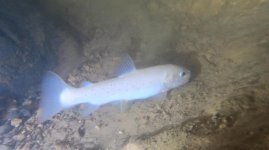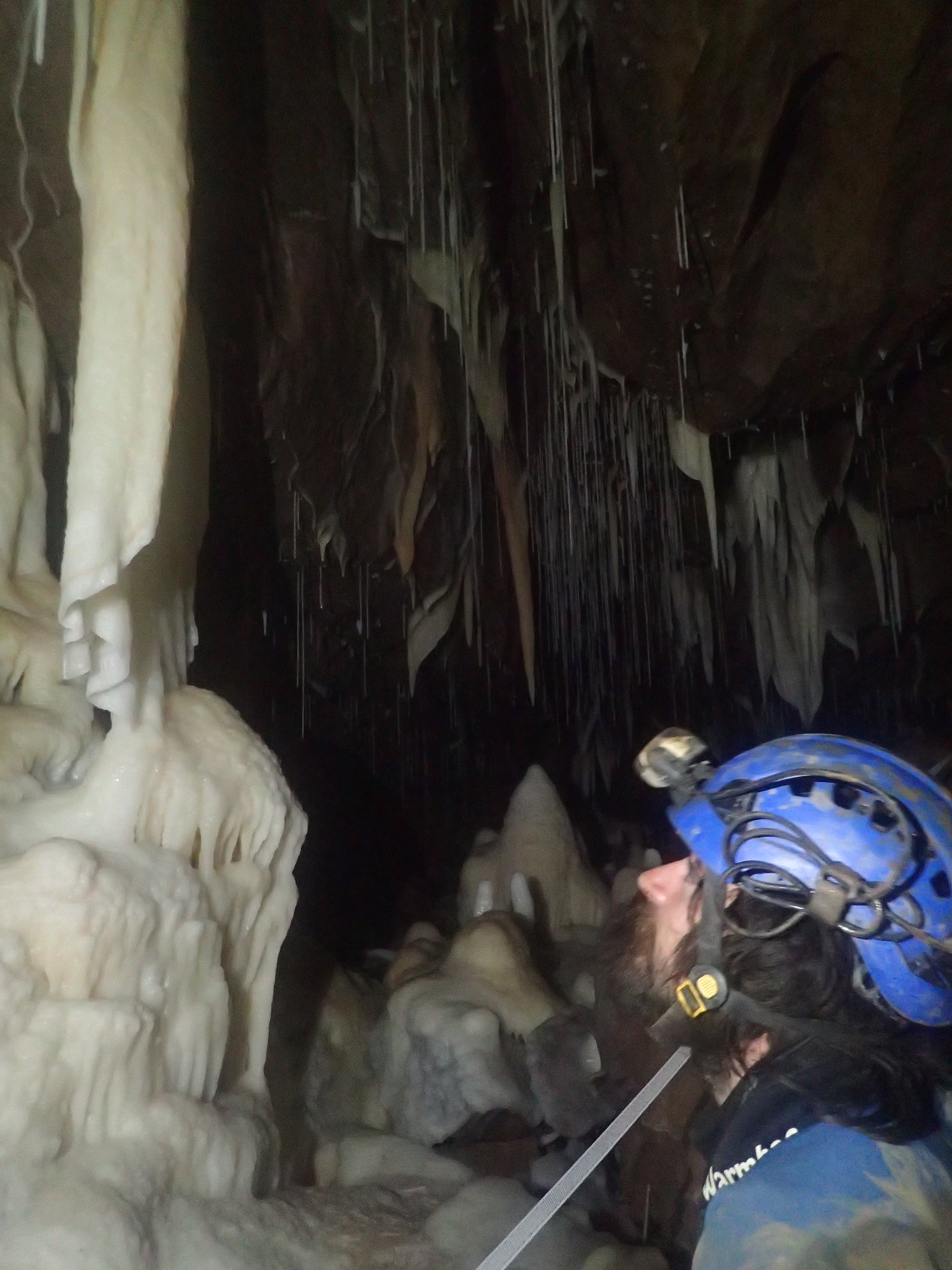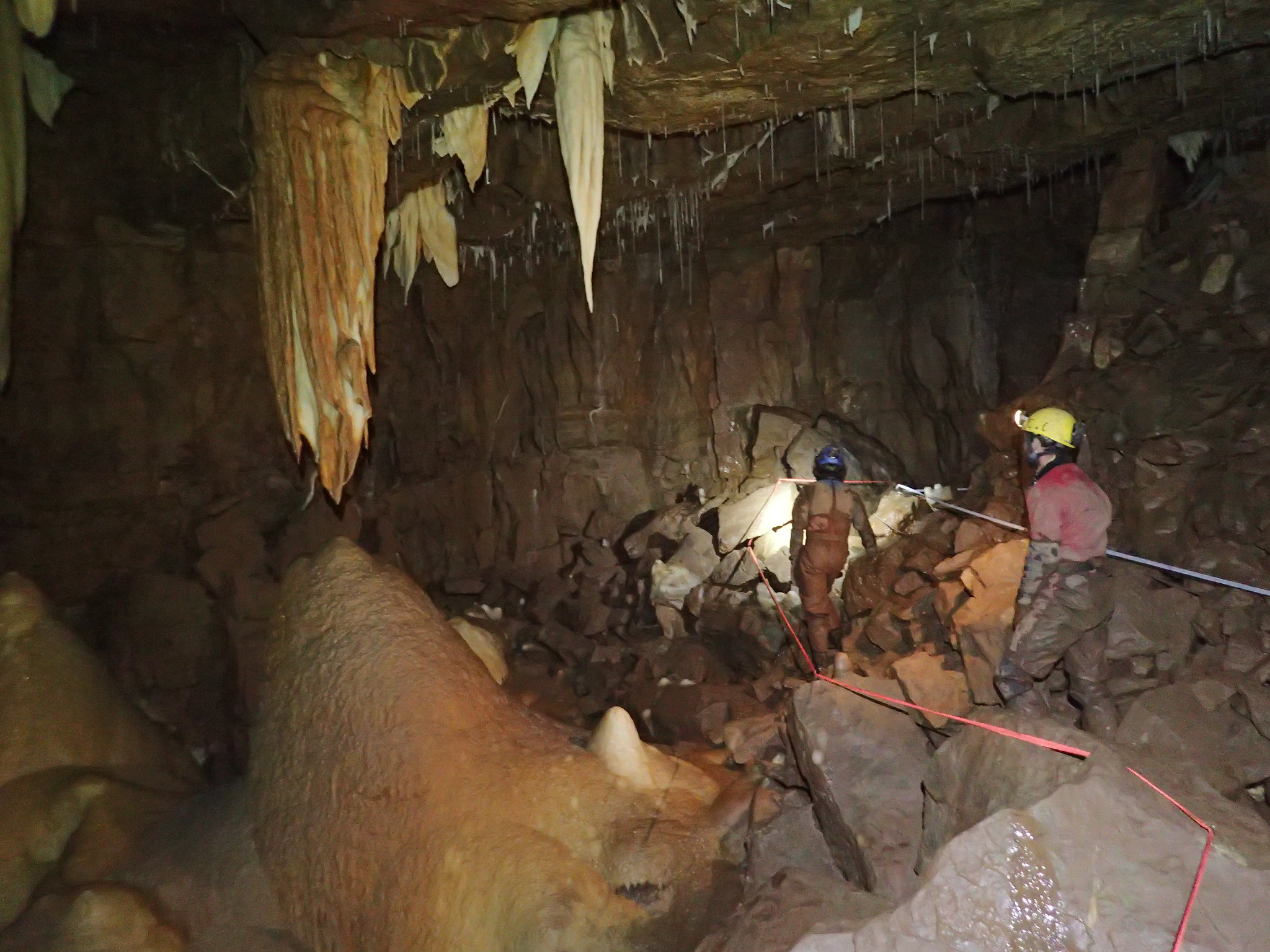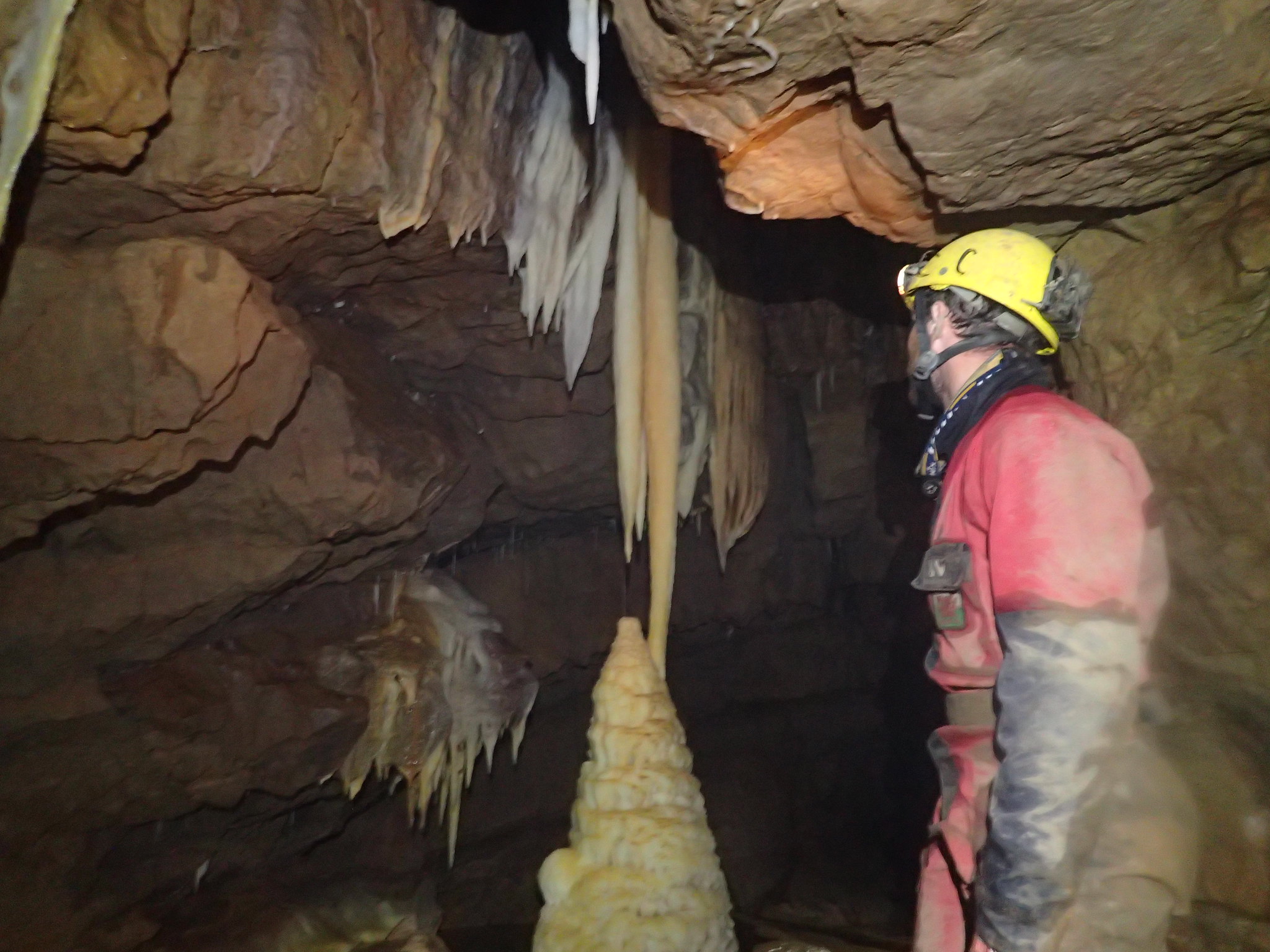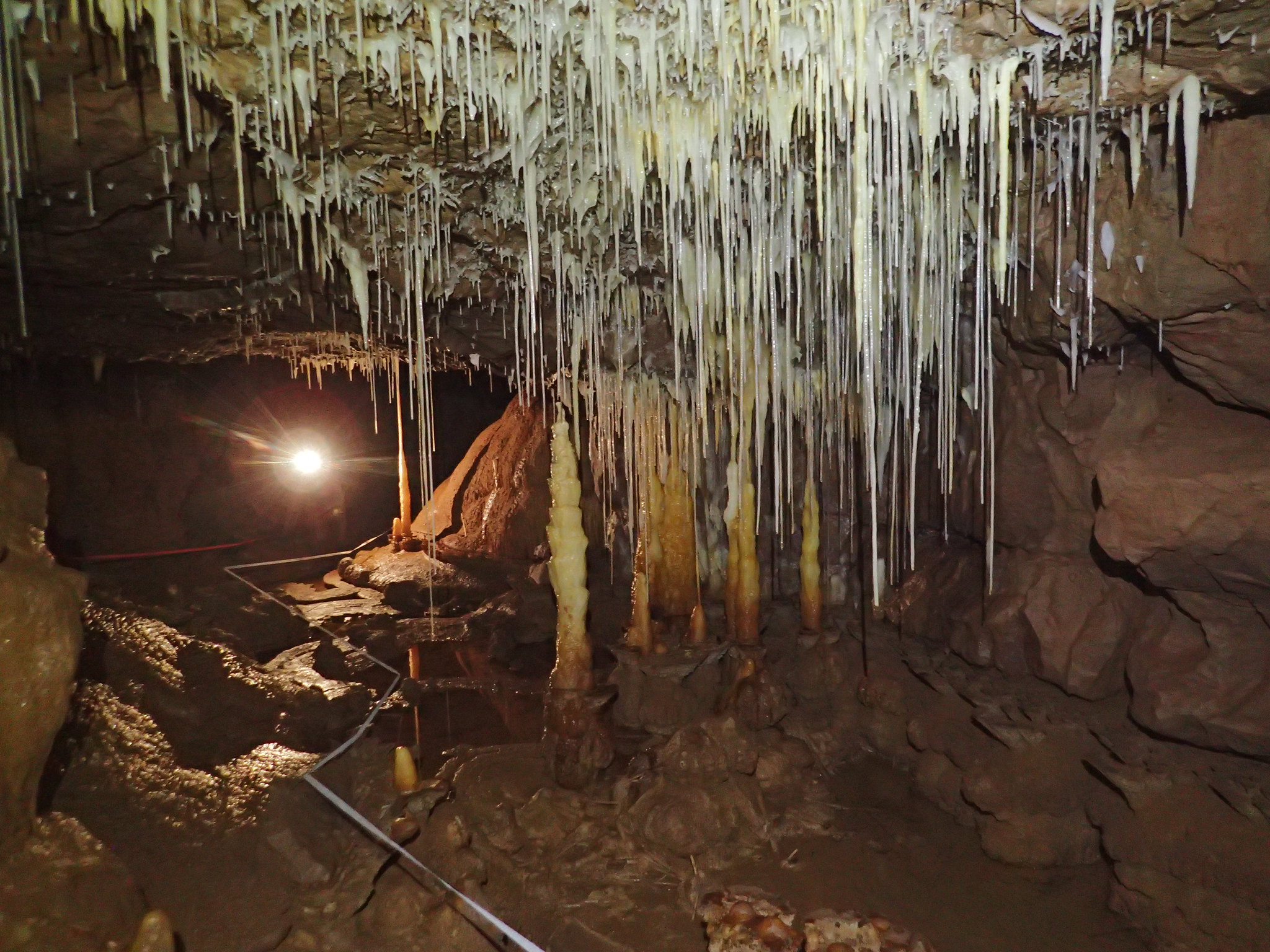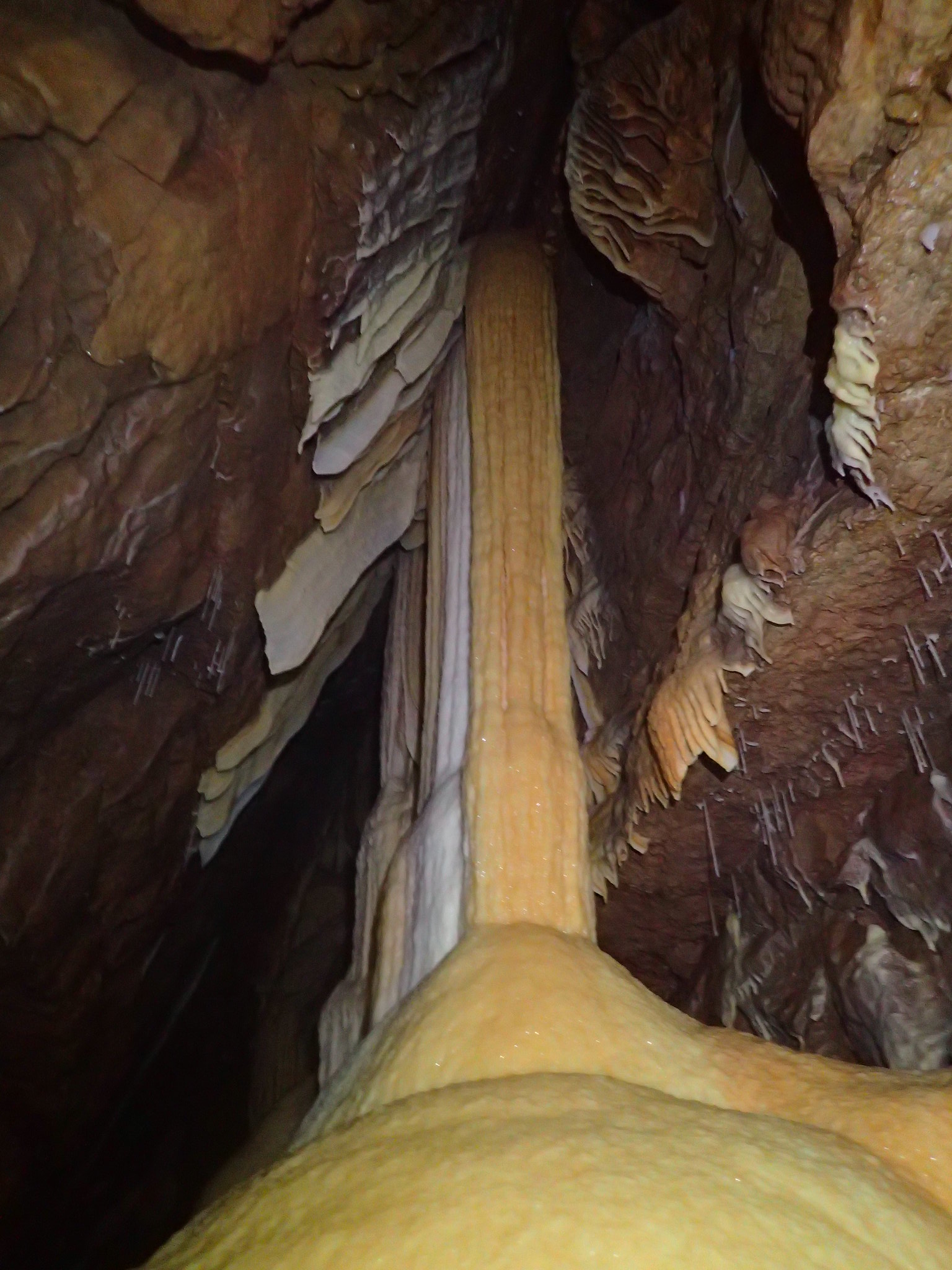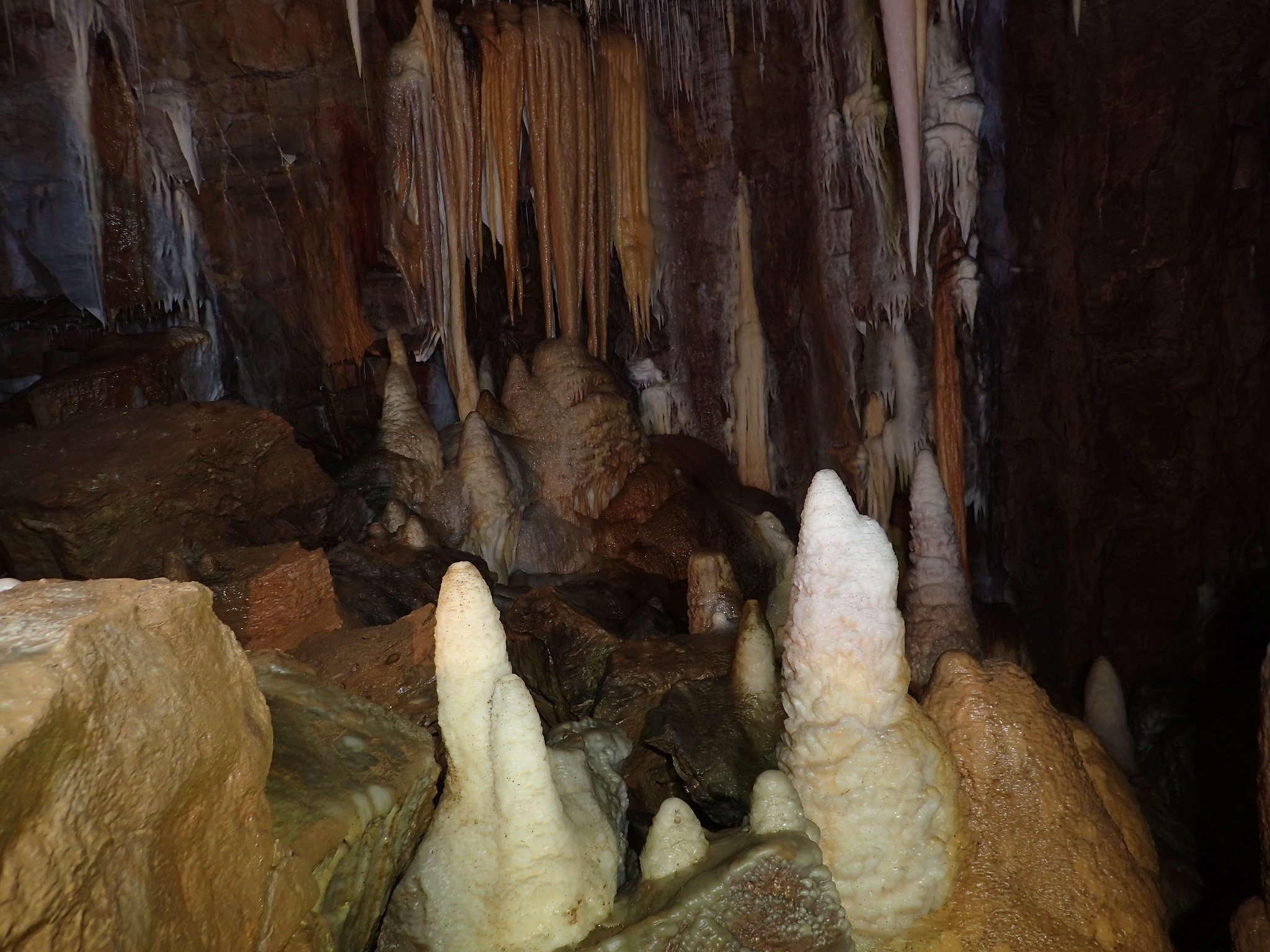PeteHall
Moderator
Otter Hole
CDG divers were invited to support an ongoing filming project in Otter Hole, by capturing footage in the 165m of stream passage beyond Sump 4.
A recci trip was made on 12th June to ensure all sumps were open and lined before dragging in all the filming kit; the sumps were last dived in the mid-nineties, so we really didn't know what to expect. This was successful and a return was made on 3rd July to do the filming.
For those unfamiliar with Otter Hole, timings are critical. About an hour into the cave is a tidal sump (Sump 1), which can only be passed during a 6 hour window at low tide; the sump then closes for the next 6.5 hours over the high tide, so if you miss your window, you'll have a long wait! On this occasion, we were doing an 'over tides' trip, entering as the tide was rising and heading out again after the tide had dropped and the sump re-opened. This meant entering the cave 2 hours before the sump was due to close and exiting no sooner than 1 hour after the sump re-opened; so minimum 9.5 hours underground.
Despite leaving diving cylinders in the cave on the first trip, we still ended up with a decent sized bag each for the way in, making for steady progress through the entrance series which generally consists of a lot of crawling in squalid tidal mud and lethally slippery climbs between boulders. After just over an hour of this delightful fun, we reached the tidal sump, which was passed as a pleasant wallow under an arch and into the more pleasant passages beyond. Again, lots of climbing between boulders, but less crawling and the occasional respite of easy stream passage.
On reaching Sump 2, I made a quick free-dive with a length of old climbing rope to rig up a more appropriate free-dive line, allowing the non-divers to pass the short sump and assist with filming in the air-bell chamber beyond. By the time I returned, the 'dry' filming party had arrived to capture some footage of the divers kitting up.
Craig dived first to film the sump while visibility was decent, followed by Footleg making a free-dive again in hopefully decent(ish) viz, with the other divers brining up the rear. After capturing some footage between sumps, Craig set off into sump 3, again filming as he went, though visibility was poor even for the first though. By the time I dived (no. 3) viz was pretty much non-existent and the highly buoyant Peli-case (despite 2.5kg of lead in it) snagged on the roof at every opportunity.
The divers congregated in the air-bell before sump 4, where those who had been through before (myself and George) explained the underwater squeeze, that must be approached with the dive-line in the right hand. a sheer wall drops from the cave roof, as a step drops away in the floor, providing a narrow slot that is wide enough to pass in just one spot (and rather awkward nonetheless). Craig set off, line in left hand and after a short while returned, though his wellies had hardly left he air-bell throughout this exercise. We explained again that the line should be in the right hand, but this clearly didn't make it through the neoprene hood and cave noises as he disappeared again with line in left hand. On the third attempt, with line in right hand, Craig disappeared once more and did not return and we duly followed through to regroup in the streamway beyond; this was where our primary objective lay.
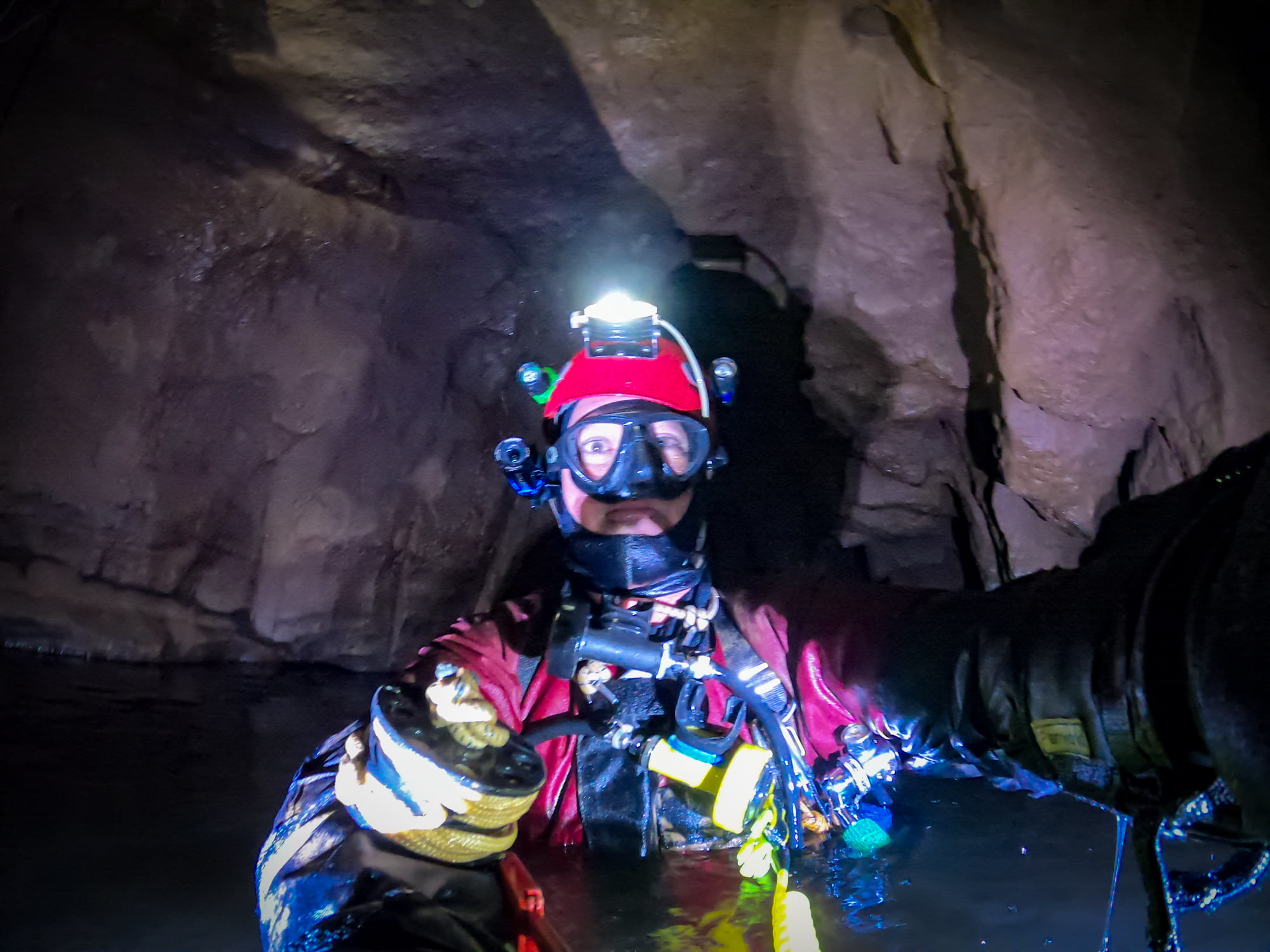
From here, Criag and I would leave diving kit and focus on filming, while Andrew and George would continue through to sump 5 with kit.

After a bit of faff with the equipment, we soon settled into a routine making steady progress up the streamway until a low section forces a move up into an oxbow above and through a bouldery squeeze before descending back to the stream. This would be no great challenge if it were not for the dive cylinders, providing some good entertainment for those of us without. Immediately beyond this squeeze, a climb leads to a possible connection to the cave above (accessible to non-divers); a secondary objective was to test an audio connection with a team above, however with the noise water, it was not possible to detect any sound of cavers above. I did however find a length of bang wire half way up the climb, which had fallen through from previous digging activities above, so it's clearly not far to go to the breakthrough.
Continuing upstream, we reached sump 5 where George and Andrew would dive while Craig and I took some still photographs in the streamway. While setting up for a photo at the dive base, I took one of the lights over to the side of the passage, intending to put it just below water and light up the sump pool and to my amazement spotted a pure white fish, perhaps 8" long resting in the calm water away from the main flow. The fish clearly wasn't so pleased to see us as we were to see it, but we did manage to get some close-up video before it swam off (it was spotted back in the same spot a little later on, so can't have been too upset).
George dived Sump 5, and entered Sump 6; having now lost the flow, the viz quickly disappeared and with several loose lines floating about and one entanglement already suffered, he decided to return.

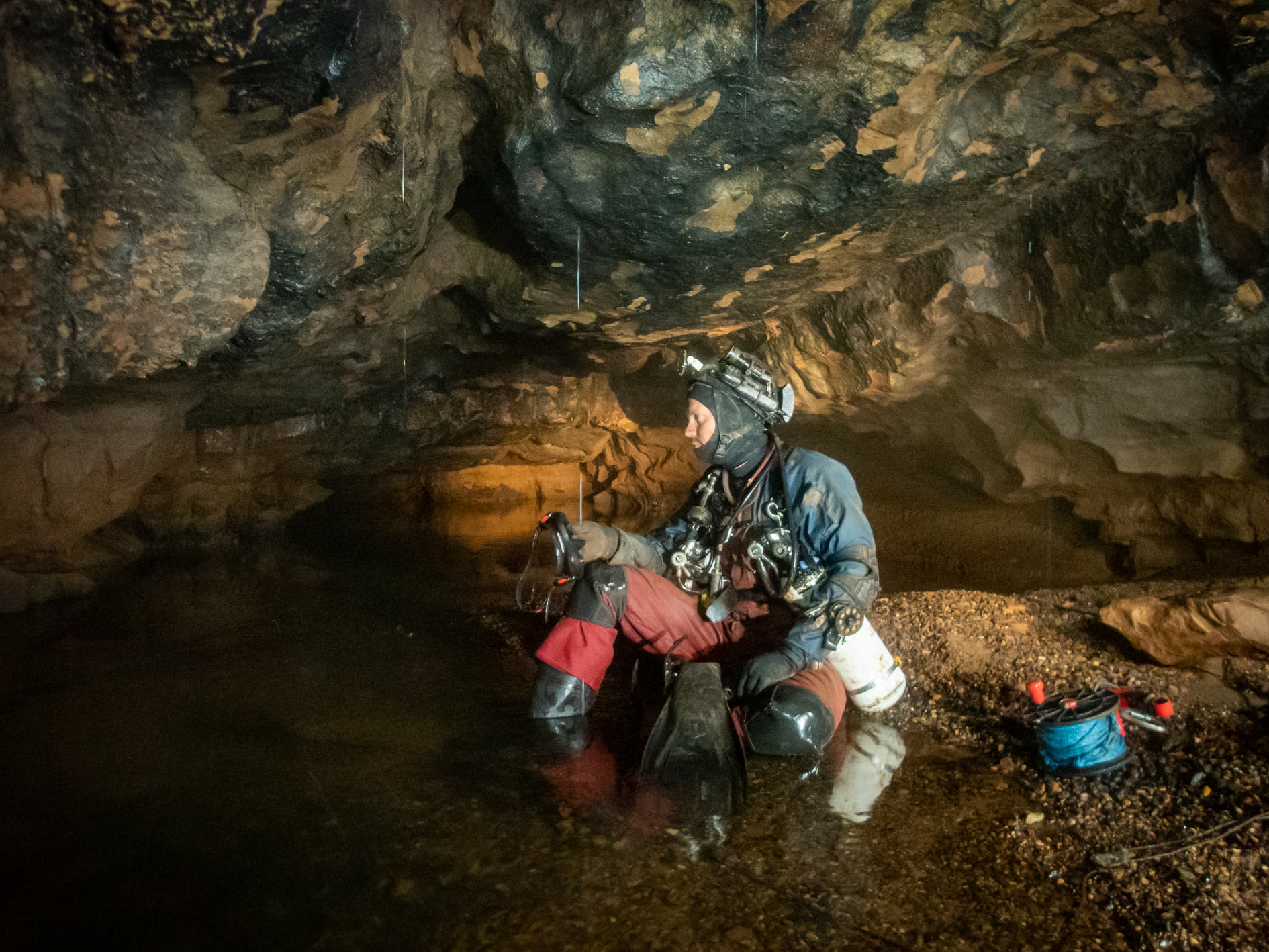
Andrew dived next with the camera and lights to capture some footage between the sumps. The divers then overtook us, as Craig and I carried on with the photography, regrouping a short while later at Sump 4 dive base. Below is a selection of photos from along the way:
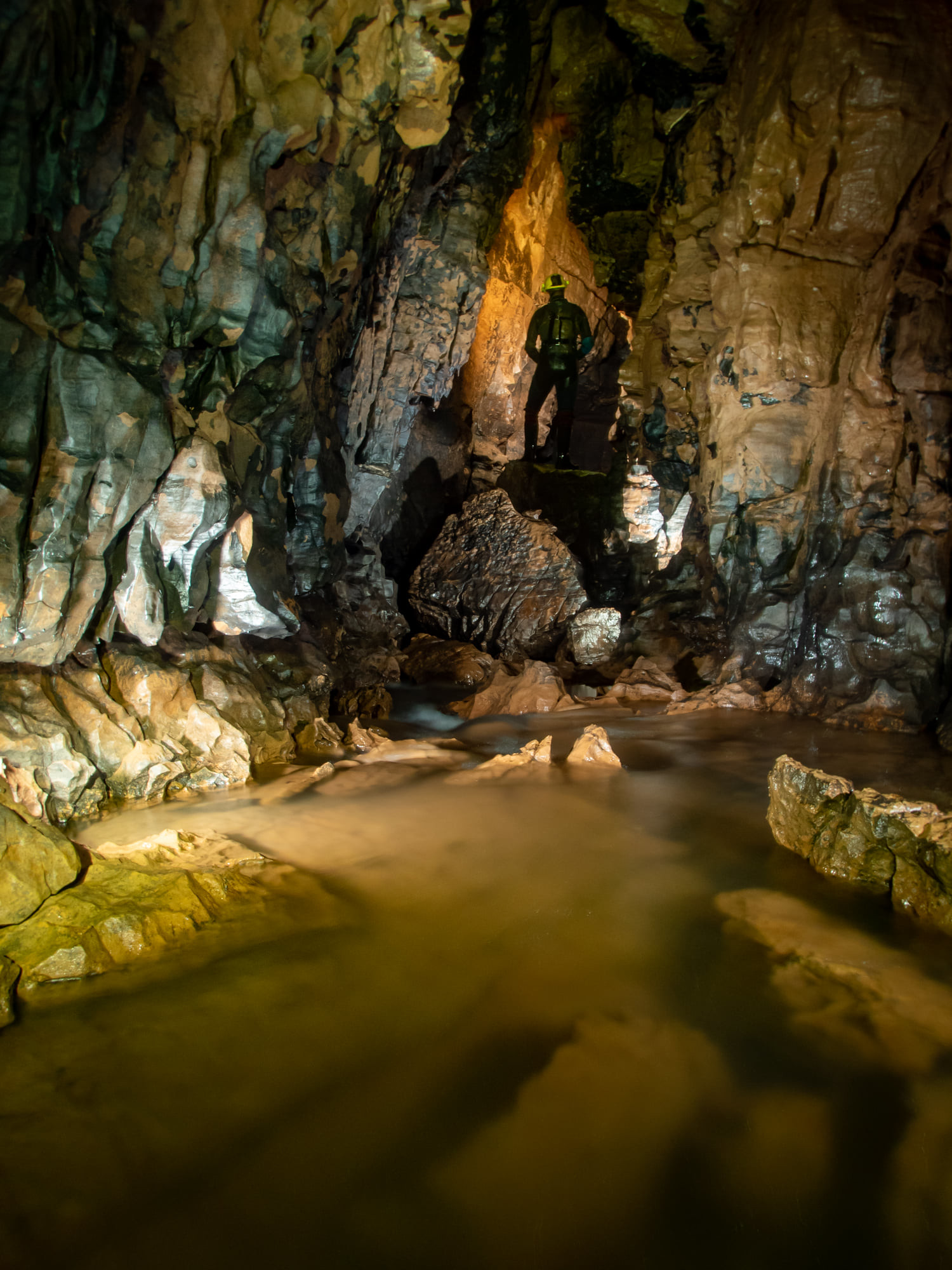


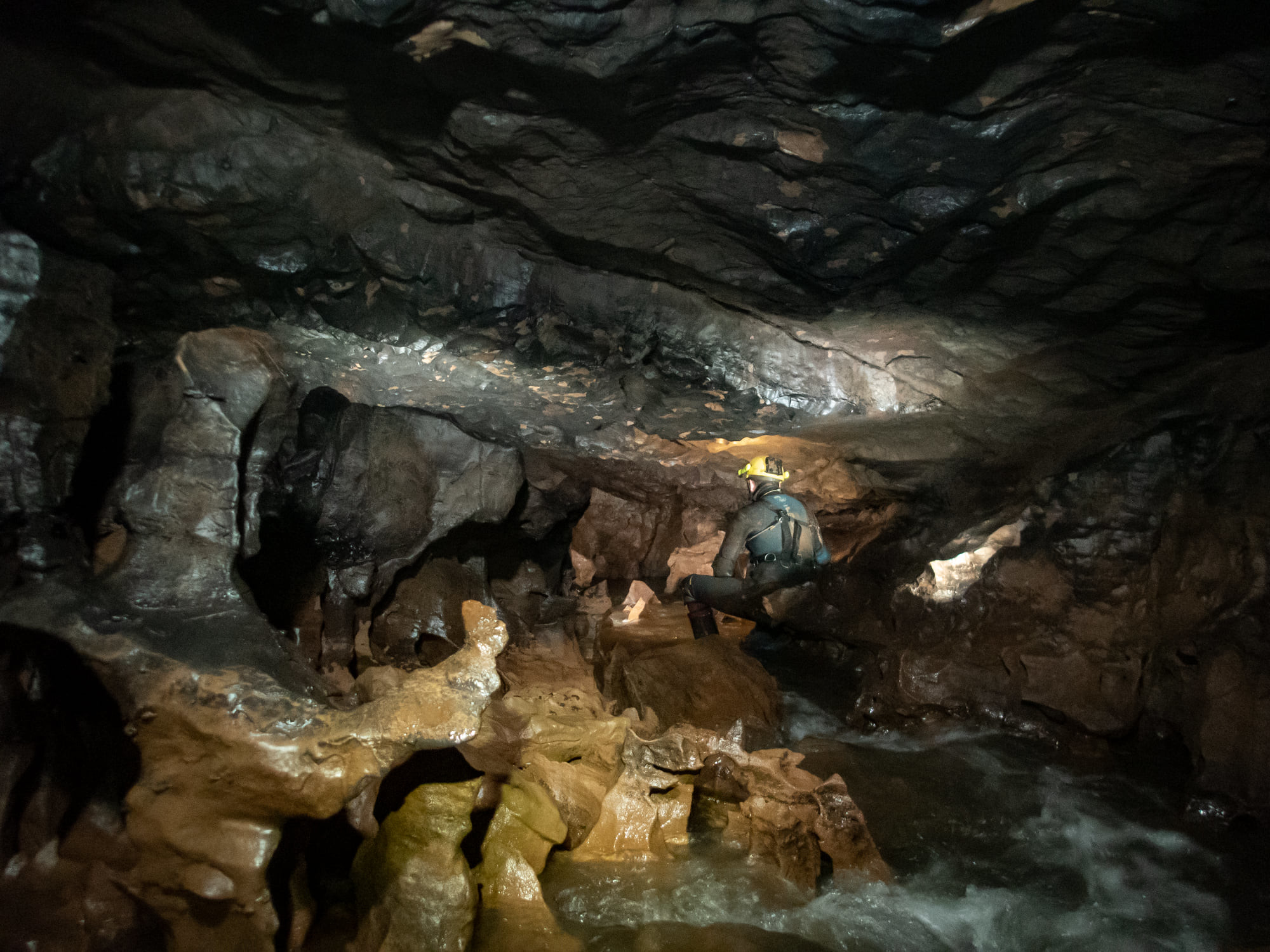





With the mission accomplished, we now just had to get ourselves and all the kit back out of the cave... To keep the Peli-case under control in the sumps and prevent snagging, I opted to carry it in my hand rather than dragging it on a lanyard as I had before. In zero viz, with a big floaty box in one hand and taking care not to lose the line with the other, finding the wide point in the Sump 4 slot was a tad awkward; fortunately the sump is short and the line is fairly tight, so you're never too far away from where you need to be and after shoving the case ahead of me, I wormed my way through and back to the air-bell. From here, Sump 3 was uneventful, with the case firmly in-hand and likewise for Sump 2.
Back on the dry side of sump 2 at about 5pm, the filming team conducted some brief interviews with the divers, while we scoffed a bit of chocolate and some pork scratchings (our first nourishment since breakfast), and packed up kit. We opted to leave two sets of cylinders in the cave for the next dive, which free of filming duties, should see slightly quicker progress. Even so, we still ended up with one more bag than pairs of hands to carry, however one of the other group (who had been doing some photography and interviews elsewhere in the cave) returned with spare batteries for one of our group and was able to relieve me of my second bag after less than 10 minutes.
Steady progress back through the cave saw us meet the other group shortly before the tidal sump, which was now nicely open. They had been waiting nearby in a more comfortable spot, rather than at the sump pool where it is a horrific mess of tidal mud!
Variously regrouping and splitting as obstacles dictated, the extended party (of at least 12, but possibly more) wormed their way back through the muddy crawls and squeezes, arriving back at the entrance some 10.5 hours after we'd first entered; more like 12 hours for some, who'd headed in earlier than the main group.
This trip not only marked the completion of a 7 year filming project in the cave, it also marked the 250th trip for Paul Taylor which, considering the grim entrance series, is about 249 more than most people would ever wish for!
Champaign was served to 'everybody brown' at the entrance, before the long slog back up the hill to the car park.
A great trip and really looking forward to Paul's film when he's finished the post-production in the next seven years perhaps
Divers: Peter Hall, Craig Holdstock, George Linnane, Andrew Rice.
Sherpas: Monica Bolani, Tom Chatterton, Becca Kirkpatrick, Maria Lynch.
Filming team: Paul Taylor, Footleg and many more who were not directly involved with our part of the project.
Photo credit: Craig Holdstock
Saturday 3rd July 2021
CDG divers were invited to support an ongoing filming project in Otter Hole, by capturing footage in the 165m of stream passage beyond Sump 4.
A recci trip was made on 12th June to ensure all sumps were open and lined before dragging in all the filming kit; the sumps were last dived in the mid-nineties, so we really didn't know what to expect. This was successful and a return was made on 3rd July to do the filming.
For those unfamiliar with Otter Hole, timings are critical. About an hour into the cave is a tidal sump (Sump 1), which can only be passed during a 6 hour window at low tide; the sump then closes for the next 6.5 hours over the high tide, so if you miss your window, you'll have a long wait! On this occasion, we were doing an 'over tides' trip, entering as the tide was rising and heading out again after the tide had dropped and the sump re-opened. This meant entering the cave 2 hours before the sump was due to close and exiting no sooner than 1 hour after the sump re-opened; so minimum 9.5 hours underground.
Despite leaving diving cylinders in the cave on the first trip, we still ended up with a decent sized bag each for the way in, making for steady progress through the entrance series which generally consists of a lot of crawling in squalid tidal mud and lethally slippery climbs between boulders. After just over an hour of this delightful fun, we reached the tidal sump, which was passed as a pleasant wallow under an arch and into the more pleasant passages beyond. Again, lots of climbing between boulders, but less crawling and the occasional respite of easy stream passage.
On reaching Sump 2, I made a quick free-dive with a length of old climbing rope to rig up a more appropriate free-dive line, allowing the non-divers to pass the short sump and assist with filming in the air-bell chamber beyond. By the time I returned, the 'dry' filming party had arrived to capture some footage of the divers kitting up.
Craig dived first to film the sump while visibility was decent, followed by Footleg making a free-dive again in hopefully decent(ish) viz, with the other divers brining up the rear. After capturing some footage between sumps, Craig set off into sump 3, again filming as he went, though visibility was poor even for the first though. By the time I dived (no. 3) viz was pretty much non-existent and the highly buoyant Peli-case (despite 2.5kg of lead in it) snagged on the roof at every opportunity.
The divers congregated in the air-bell before sump 4, where those who had been through before (myself and George) explained the underwater squeeze, that must be approached with the dive-line in the right hand. a sheer wall drops from the cave roof, as a step drops away in the floor, providing a narrow slot that is wide enough to pass in just one spot (and rather awkward nonetheless). Craig set off, line in left hand and after a short while returned, though his wellies had hardly left he air-bell throughout this exercise. We explained again that the line should be in the right hand, but this clearly didn't make it through the neoprene hood and cave noises as he disappeared again with line in left hand. On the third attempt, with line in right hand, Craig disappeared once more and did not return and we duly followed through to regroup in the streamway beyond; this was where our primary objective lay.

From here, Criag and I would leave diving kit and focus on filming, while Andrew and George would continue through to sump 5 with kit.

After a bit of faff with the equipment, we soon settled into a routine making steady progress up the streamway until a low section forces a move up into an oxbow above and through a bouldery squeeze before descending back to the stream. This would be no great challenge if it were not for the dive cylinders, providing some good entertainment for those of us without. Immediately beyond this squeeze, a climb leads to a possible connection to the cave above (accessible to non-divers); a secondary objective was to test an audio connection with a team above, however with the noise water, it was not possible to detect any sound of cavers above. I did however find a length of bang wire half way up the climb, which had fallen through from previous digging activities above, so it's clearly not far to go to the breakthrough.
Continuing upstream, we reached sump 5 where George and Andrew would dive while Craig and I took some still photographs in the streamway. While setting up for a photo at the dive base, I took one of the lights over to the side of the passage, intending to put it just below water and light up the sump pool and to my amazement spotted a pure white fish, perhaps 8" long resting in the calm water away from the main flow. The fish clearly wasn't so pleased to see us as we were to see it, but we did manage to get some close-up video before it swam off (it was spotted back in the same spot a little later on, so can't have been too upset).
George dived Sump 5, and entered Sump 6; having now lost the flow, the viz quickly disappeared and with several loose lines floating about and one entanglement already suffered, he decided to return.


Andrew dived next with the camera and lights to capture some footage between the sumps. The divers then overtook us, as Craig and I carried on with the photography, regrouping a short while later at Sump 4 dive base. Below is a selection of photos from along the way:









With the mission accomplished, we now just had to get ourselves and all the kit back out of the cave... To keep the Peli-case under control in the sumps and prevent snagging, I opted to carry it in my hand rather than dragging it on a lanyard as I had before. In zero viz, with a big floaty box in one hand and taking care not to lose the line with the other, finding the wide point in the Sump 4 slot was a tad awkward; fortunately the sump is short and the line is fairly tight, so you're never too far away from where you need to be and after shoving the case ahead of me, I wormed my way through and back to the air-bell. From here, Sump 3 was uneventful, with the case firmly in-hand and likewise for Sump 2.
Back on the dry side of sump 2 at about 5pm, the filming team conducted some brief interviews with the divers, while we scoffed a bit of chocolate and some pork scratchings (our first nourishment since breakfast), and packed up kit. We opted to leave two sets of cylinders in the cave for the next dive, which free of filming duties, should see slightly quicker progress. Even so, we still ended up with one more bag than pairs of hands to carry, however one of the other group (who had been doing some photography and interviews elsewhere in the cave) returned with spare batteries for one of our group and was able to relieve me of my second bag after less than 10 minutes.
Steady progress back through the cave saw us meet the other group shortly before the tidal sump, which was now nicely open. They had been waiting nearby in a more comfortable spot, rather than at the sump pool where it is a horrific mess of tidal mud!
Variously regrouping and splitting as obstacles dictated, the extended party (of at least 12, but possibly more) wormed their way back through the muddy crawls and squeezes, arriving back at the entrance some 10.5 hours after we'd first entered; more like 12 hours for some, who'd headed in earlier than the main group.
This trip not only marked the completion of a 7 year filming project in the cave, it also marked the 250th trip for Paul Taylor which, considering the grim entrance series, is about 249 more than most people would ever wish for!
Champaign was served to 'everybody brown' at the entrance, before the long slog back up the hill to the car park.
A great trip and really looking forward to Paul's film when he's finished the post-production in the next seven years perhaps
Divers: Peter Hall, Craig Holdstock, George Linnane, Andrew Rice.
Sherpas: Monica Bolani, Tom Chatterton, Becca Kirkpatrick, Maria Lynch.
Filming team: Paul Taylor, Footleg and many more who were not directly involved with our part of the project.
Photo credit: Craig Holdstock



